Elementary Farming: Vital energy of vegetables detected through Sensible Crystallization
The soil in its natural state has all the characteristics of a living organism. Like us and all animals, it breathes, regenerates, It absorbs energy from everything that exists, which it uses and redistributes. Current agronomic science considers the earth as inert matter from which energy in the form of food must be extracted. The foundation of natural laws is the opposite: from the energy that the earth guards, living matter is generated, including food. In the former conception, the fruit of the earth is inert, just like the earth that is subjected to cultivation practices, irrigation, fertilization, and biocidal treatments. In the latter view, the fruits of untouched earth carry within them all the energy of Nature. The metaphor that illustrates the difference is as shocking as it is true: those who consume fruit from earth altered by agricultural intervention are like infants sucking milk from a dead mother; those who consume the fruits of untouched earth are like infants sucking milk from a living mother. Elementary Farming considers agronomic sciences and the derived agricultural practices, both conventional and certified organic, as outdated. At the core of Elementary Farming is the deep feeling that makes us an integral part of Nature, just like any other living being. This deep feeling, currently suffocated by civilization, has not disappeared from our genes and represents the existential redemption to obtain the denied serenity that we rightfully deserve at birth.
SENSIBLE CRYSTALLIZATION ANALYSIS FOR EVALUATION OF QUALITATIVE FORCES OF VEGETABLES FROM THE ELEMENTARY GARDEN
BY AGR. GIAN CARLO CAPPELLO
Curated by Marco Pighin
September 20, 2021, Porpetto (Udine)
Sensible Crystallization is a method of qualitative analysis through images developed by Ehrenfried Pfeiffer and Erika Sabarth under the guidance of Rudolf Steiner, the founder of Anthroposophical Sciences. It allows for the assessment of the quality of organic substances through the crystallization of juices and emulsions with copper chloride dihydrate salts, CuCl2 – 2H2O. The shape, complexity, branching, and overall harmony of the crystallized salt provide an evaluation of the quality and vitality level of the analyzed substances, in this case, vegetables. It also enables a comparison of products from different agricultural methodologies.
Given the complexity of the "Living," this study should not be regarded as a definitive evaluation but rather as a possible starting point for research aimed at highlighting the differences in terms of quality between vegetable products cultivated using the " Cappello Non-Method" (or Elementary Farming) founded by Agr. Gian Carlo Cappello and other cultivation practices.
In order to better highlight the concept of "quality" and "vitality," the experiments were conducted on products from different types of cultivation (conventional, organic, Elementary Farming) and with different storage methods (fresh and frozen).
The products cultivated in the Elementary Garden, which were used for the crystallization experiments in this study, were directly sourced from Agr. Gian Carlo Cappello's experimental garden located in the province of Piacenza. These products were harvested on June 22, 2021, and transported in fresh water-filled glass and plastic containers to my laboratory in Udine.
The crystallization tests were performed from June 23, 2021, and continued until July 1, 2021. During this period, the vegetables were stored in containers with water in the refrigerator.
First, the crystallization of the leaves, which tend to lose vitality more quickly, was carried out, followed by other vegetables such as zucchini and peas.
For the comparison products from other cultivation methodologies, it was not possible to determine the exact date of harvest as indicated on the label.
1) COMPARISON OF VITAL FORCES IN FRESH (from Elementary Farming) AND FROZEN (from conventional cultivation) PRODUCTS
a) FRESH PEAS FROM ELEMENTARY FARMING
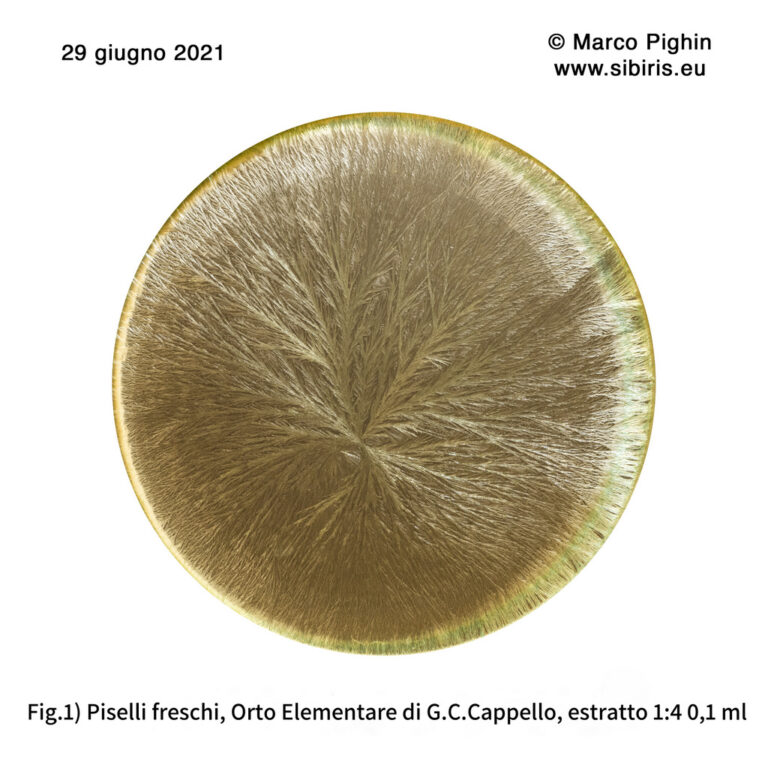
The image shows a centralized structure with a single germinal center positioned quite centrally.
Remarkable vitality is evident throughout the texture of secondary branching, extending from the central area to the outermost periphery, except for a slight impoverishment in the peripheral zone from 2 o'clock to 6 o'clock, which is marginal in the overall view.
There is a densification in the central zone, most likely due to the fact that the pea expresses the phase of embryonic concentration (seed) in the living metamorphosis of the plant. However, it should be noted that these central condensations are not sclerotization but a concentration of countless individual bundles of crystals that, as they move towards the periphery, arrange themselves more and more harmoniously in the middle zone, that is, in the aerial zone of light. They then continue to branch intensively with full vitality even in the extreme periphery, the zone of warmth. Overall, we can observe a splendid image, an expression of remarkable vital forces.
b) FROZEN PEAS FROM THE SUPERMARKET ORIGINATING FROM CONVENTIONAL FARMING
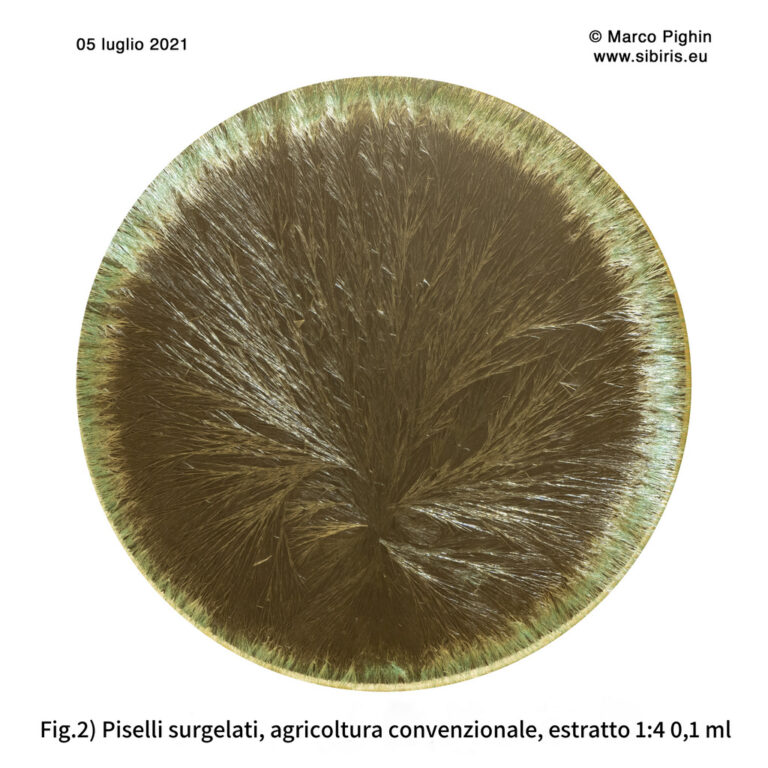
The germinal center is not well-defined and presents multiple incoherent lateral branches; this could be a symptom of weakness in the ether of life.
The crystals are dull everywhere and have weak branching. If we enlarge the image, we can see that there are traces of incoherent lateral branches scattered throughout, perhaps indicating a weak action of the ether of light.
In conclusion, the vitality and consequent nutritional power of these peas, cultivated conventionally and frozen, are significantly lower compared to peas cultivated in an Elementary Farming manner by Agr. G. C. Cappello.
CONCLUSIONS ON THE TWO ANALYSES RELATED TO PEAS
The careful and repeated comparison between the two images can help us not only to grasp the great qualitative superiority of fresh and natural peas cultivated by Agr. Cappello in Elementary Farming compared to conventionally frozen ones but can also serve as a tool for contemplating the dynamics of “Living” processes.
What facilitates life? How can we harmoniously collaborate with it?
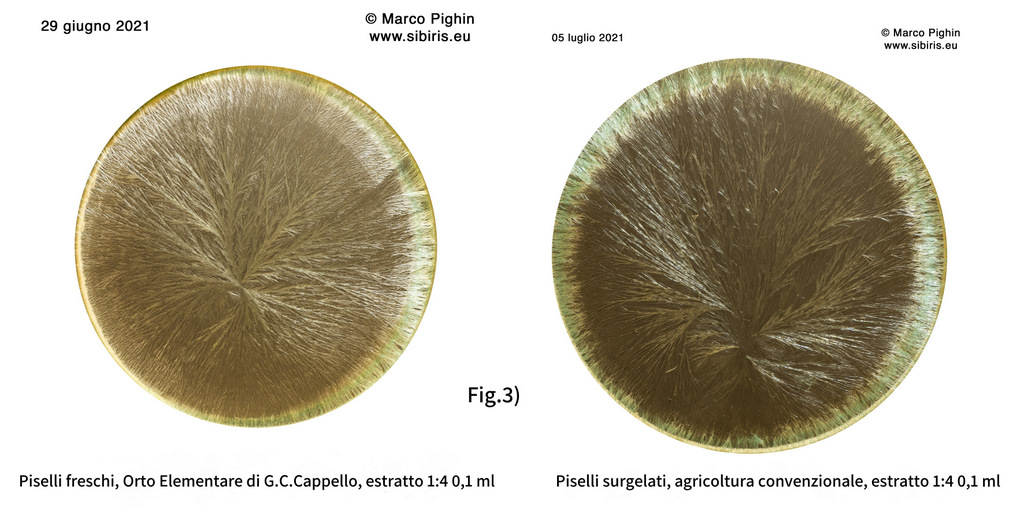
2) COMPARISON OF VITAL FORCES IN LETTUCE FROM ELEMENTARY FARMING AND CONVENTIONAL FARMING
a) BATAVIA LETTUCE FROM ELEMENTARY FARMING
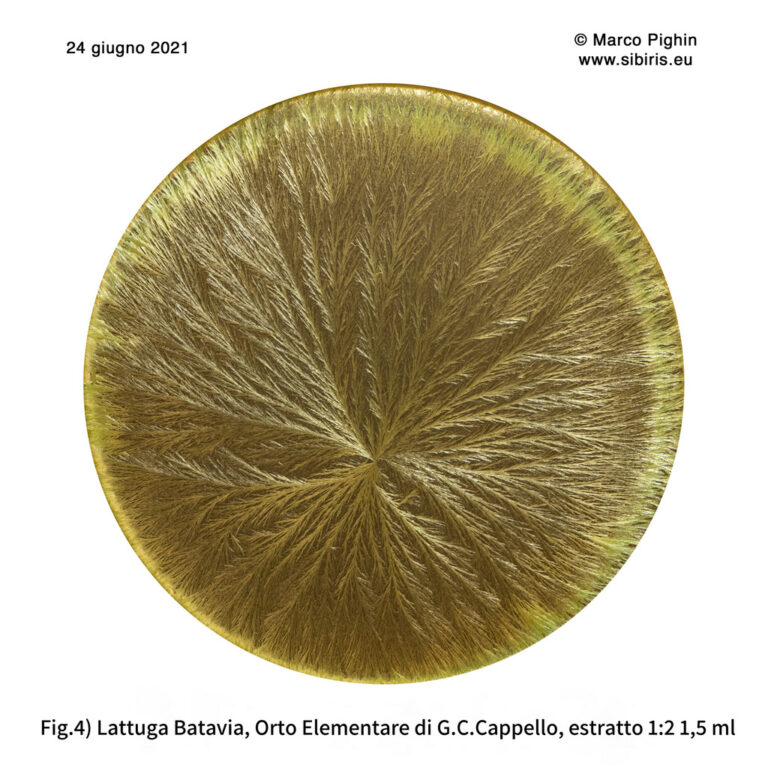
Essentially, in this beautiful image, we find the constant harmony and balance that characterize all the crystallizations performed on vegetables cultivated by Agr. Gian Carlo Cappello: a unique and fairly well-defined germinal center; vibrant and flexible crystals; high branching; evident coherence among all areas of crystallization from the center to the periphery, indicating a homogeneous and healthy action of all ethers (life, chemistry, light, warmth) corresponding to the four fields of action (earth, water, air, fire) in which the hypersensitive being unfolds, condensing itself into the sensitive plant. Instead of focusing on the individual image, let us take advantage of this experiment on lettuce to observe, compare, and understand the difference between the two types of products in the following images: lettuce from Elementary Farming and lettuce from conventional cultivation.
b) “GENTILE VERDE” LETTUCE FROM CONVENTIONAL FARMING
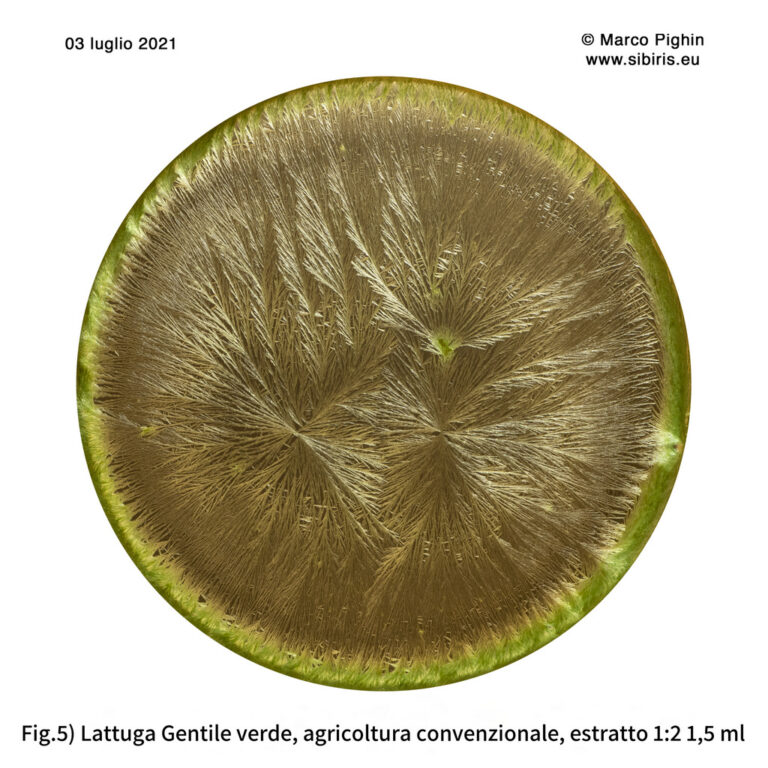
The image resulting from the crystallization of Gentile Verde lettuce cultivated conventionally is very interesting in our comparative study. This image reveals significant differences compared to the previous crystallization obtained with lettuce cultivated in the Elementary Garden.
Normally, in Sensible Crystallization, the quality of crystals is not easily "readable" and understandable to those who are not crystallographers. In this experiment, the differences are so striking that they can be easily read and understood even by those unfamiliar with this method of analysis.
Firstly, we observe that the crystallization of lettuce from conventional farming presents three germinal centers: two well-defined and autonomous centers located in the central region, and another generated from branching that extends upwards from the right germinal center. The interesting aspect of this third germinal center is that it represents the result of an accumulation of copper chloride salts. The green deposit is the expression of a severe deficiency in formative forces (vitality) that prevents the structuring of salts into further branching: salts not conveyed by vital forces remain inert and agglomerate according to the natural condition of pure minerals (see Figure 6).
The absence of a single germinal center and the accumulation of salts from which an additional germinal center is generated is a symptom of low vitality, especially when observed in relation to the overall image.
In this image, we notice that the crystals are rigid, not easily flexibles, and lacking in harmonious and flexuous branching, which are found in the image of lettuce from the Elementary Garden of Agr. G.C. Cappello.
Another phenomenon that stands out in this image is the presence of crystals positioned at a 90° angle along the branches, as can be seen in Figure 7. This arrangement reveals a lack of force capable of conveying, extending, and radiating the texture of branching. These short-length crystals resemble aborted branches and indicate a severe impoverishment of the vital force contained in the sap of this lettuce, especially considering their abundance.
CONCLUSIONS ON THE TWO ANALYSES RELATED TO LETTUCE
The qualitative difference between lettuce from Elementary Farming and lettuce from conventional farming is truly enormous, evident from a panoramic comparative observation between the two images as well as by focusing on individual details. This experiment can also be useful for educational purposes, as it empirically demonstrates, at a glance, the significant difference in quality between food products obtained from wise and truly natural farming that respects natural rhythms and processes, and other products derived from industrialized agriculture that relies on synthetic chemicals.
a) DETAIL OF CRYSTALLIZATION OF GENTILE VERDE LETTUCE FROM CONVENTIONAL FARMING: INERT ACCUMULATION OF SALTS.
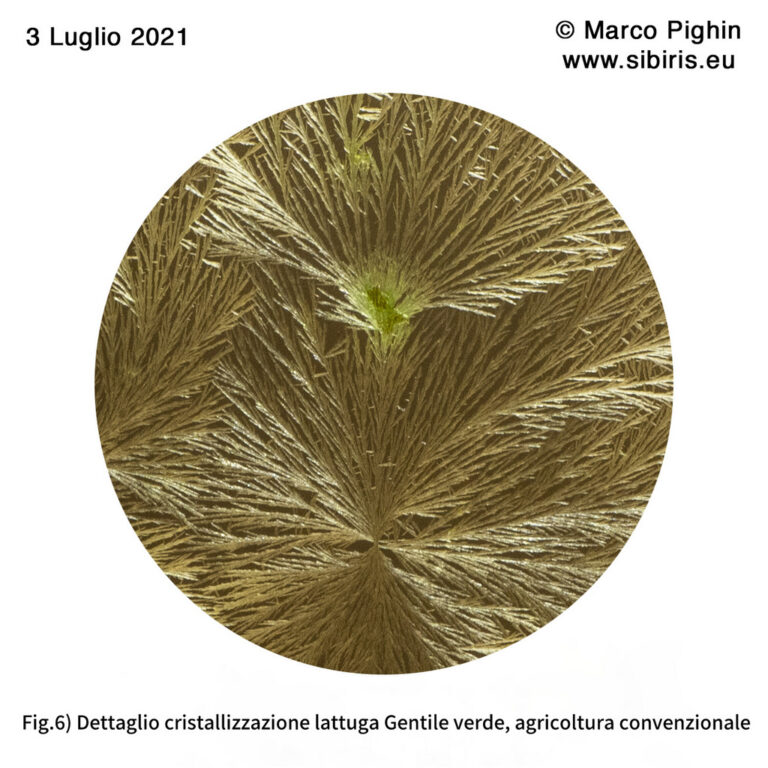
b) DETAIL OF CRYSTALLIZATION OF GENTILE VERDE LETTUCE FROM CONVENTIONAL FARMING: PERPENDICULAR AND INCOHERENT BRANCHING
This detail is located in the upper part of the image between 12 o'clock and 1 o'clock, in the area between the center of the image and the periphery.
COMPARISON OF QUALITY BETWEEN ZUCCHINI FROM ELEMENTARY FARMING AND ORGANIC CERTIFIED FARMING

Zucchini from Elementary Farming. The image is well-centered and completely harmonious in its development from the center to the periphery. A sense of absolute coherence permeates this extraordinary image, both in its overall appearance and in the details. Here, the crystals organize themselves into thin, multiple, and fluid branches. The vitality is very high and is expressed in an image that touches perfection.
Zucchini from organic certified farming. This zucchini was purchased from an organic store, and I do not know the exact origin, precise harvest date, or storage methods after harvest. However, at the time of preparation in the laboratory, the zucchini still appeared intact and vital. The germination center is not well-centered like in the crystallization of zucchini cultivated by G. C. Cappello. Despite remaining an image that expresses a certain overall harmony and good quality, there are significant and perceptible differences compared to the zucchini from Elementary Farming, even to non-experts. The branching appears more rigid, weak, and contracted. Between the germination center and the circumference at 6 o'clock, crystals can be observed that are positioned perpendicularly to the originating branches (see detail Figure 9), indicating a vital impoverishment, that is, an inability of formative forces to organize the mineral substance into coherent forms. perpendicolarmente rispetto alle ramificazioni di provenienza (vedi dettaglio Fig. 9), il che lascia intendere un impoverimento vitale, cioè un’incapacità nelle forze plasmatrici di organizzare la sostanza minerale in forme coerenti.
When comparing the two images, the branches of the "organic" zucchini appear poorer, depleted, and stiff compared to those observed in the zucchini from the Elementary Garden of Agr. Gian Carlo Cappello.

GENERAL CONCLUSIONS ON THE SENSIBLE CRYSTALLIZATION ANALYSES PERFORMED WITH VEGETABLES FROM ELEMENTARY FARMING
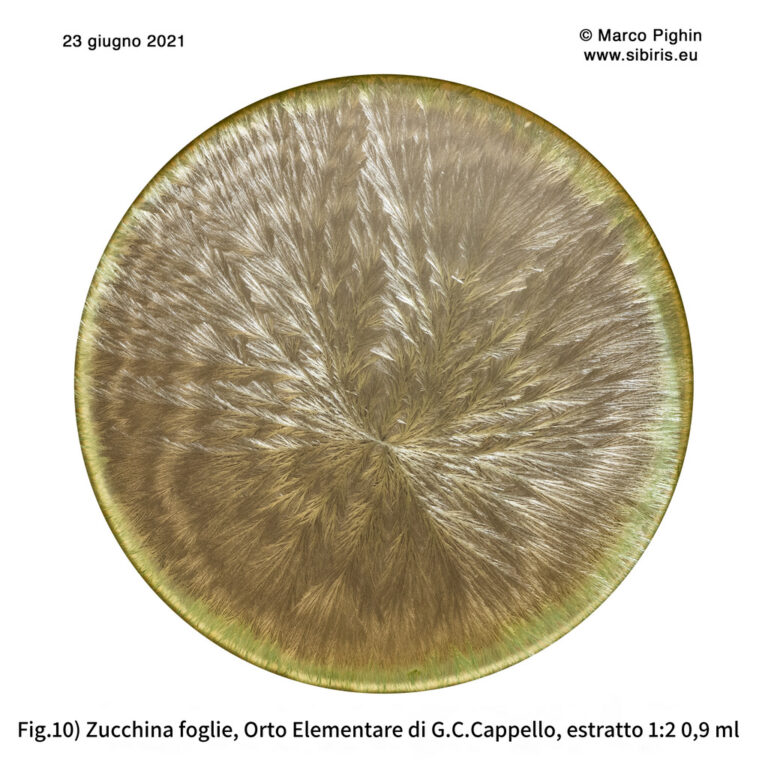
In the Sensible Crystallizations performed in the laboratory on the vegetables cultivated by G.C. Cappello in Elementary Farming, constant harmony and overall coherence are noticeable. These characteristics are found in all the images, highlighting the very high vitality of the products.
One aspect that particularly stands out is the consistent occurrence, in all the analyses, of a perfect expression of crystals throughout the crystallization area, from the center to the periphery. This means that the method of Elementary Farming allows plants to develop forces in all the "spaces" or realms of metamorphosis: Earth, Water, Air, Fire. For example, consider the formal perfection expressed in the above image from the crystallization of the juice from a zucchini leaf.
This study does not aim to be definitive in providing an overall evaluation of the "Non-Method" of Elementary Farming; rather, it represents a contribution to research on the qualitative forces resulting from the wise collaboration between the farmer and the processes of Nature implemented through the innovative practice of Agr. G.C. Cappello.
The Elementary Garden from which the vegetables were harvested was established three years ago. An interesting follow-up crystallization study could be conducted starting from a newly established garden to be monitored for at least three years. This way, it would be possible to study and observe the vital variations that occur in Elementary Farming in relation to the progressive formation of humus.
Marco Pighinfounder of the Sibiris project, was born in San Vito al Tagliamento, Pordenone, in 1973. For over a decade, he worked as a photojournalist for major Italian and foreign magazines, focusing on the Russian world and the Slavic East. He lived in the Siberian taiga for twelve years, in a small wooden house on the border with Mongolia, where he devoted himself to the study and research of the relationships between civilization, landscape, and the plant world. In the Siberian taiga, he specialized in distilling essential oils, deepening his study of these substances. In his work, he focused on observing the vital processes of plants, based on the Goethean approach and the Science of the Spirit, the foundation of all his research in different fields.
In recent years, he has integrated his research on the ” Living” through the study of Sensible Crystallization as an empirical and objective method for assessing the vitality of substances. With this analytical method, he has conducted countless studies in various areas of the plant world, water, and therapeutic substances.
In addition to his research, he carries out educational work through conferences and seminars, focusing on the study of essential oils as complex and living organisms.


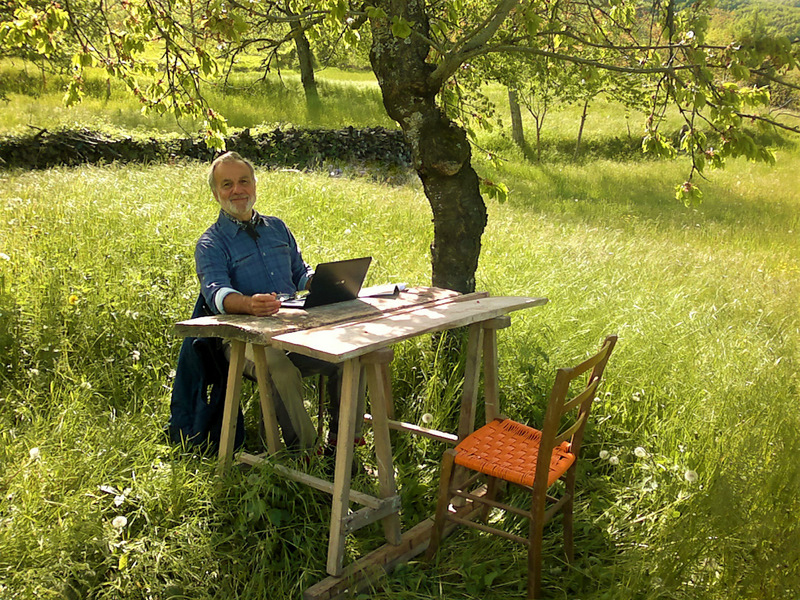
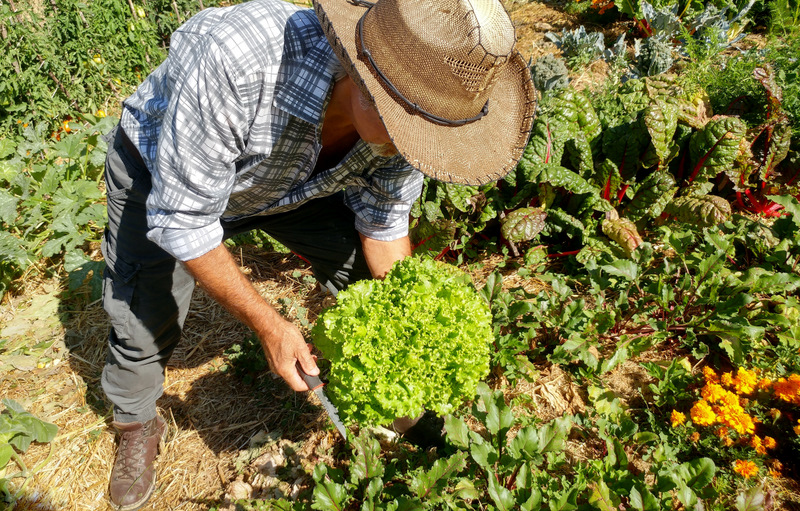
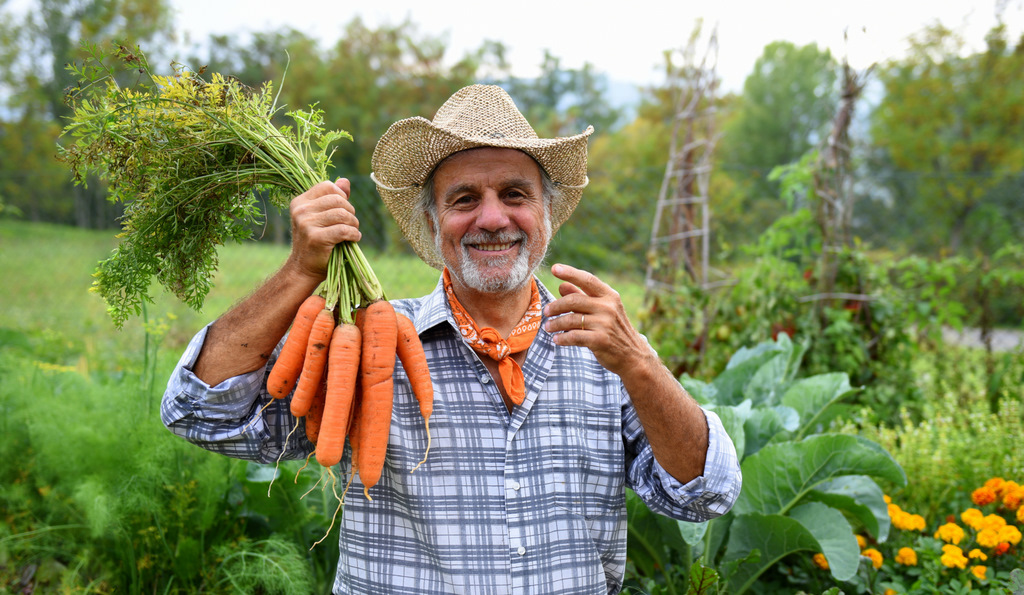
Spettacolare